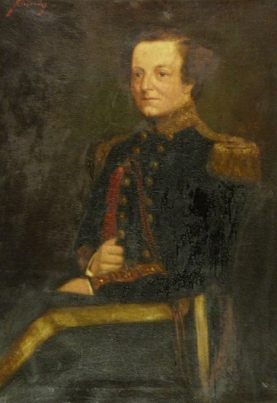Lt Frederick Ernest Gammell
1827-1902
Frederick Ernest Gammell was the second son of Captain James Gammell of Ardiffery and his wife Sydney Holmes. He was born at Beech Hill, Donoughmore, Co. Down on 3 September 1827. When he was about seven years old his parents moved to Edinburgh, where he received his education; first at a preparatory school, and then at Edinburgh Academy, where he was a pupil from 1838 to 1843. He appears to have gone on to study further, including studying Hindustani in 1944 at the Scottish Naval and Military Academy, so he obviously had a career in India in mind. In early 1845 he passed the requisite exams and was admitted at a cadet to the East India Company's Military Seminary.

In December 1846 he successfully completed his cadetship and was assigned to the infantry. At some stage he transferred to the Bengal Artillery, but he doesn't seem to have had a very successful military career, since he remained a Lieutenant until his retirement in 1858.
In 1855 he is listed as part of the “Ottoman contingent” about to proceed to the Crimea and with the local rank of Captain, but whether he went is unknown. In 1858 he was detained in Bhowanipore Lunatic Asylum (near Calcutta) and was repatriated in the "Warrior Queen". Very shortly after that, in April 1858, he retired from the service.
His gravestone records him as a Lieutenant of the Bengal Artillery and the painting on the right, which was on an auction site in Canada in 2013, shows him in the uniform of that regiment.
In the 1871 census he is boarding in Lesmahagow with the Slimon household, with Marion Slimon as one of the daughters of the household and he was still boarding there at the time of the 1881 census.

Frederick Gammell as a Lieutenant of the Bengal Artillery
Clearly romance flourished and the next we hear of him is that on 20 December 1883, he was married at Hackney Parish Church to Marion Kennedy Slimon, daughter of Robert Slimon, a medical surgeon. The ceremony was conducted by his elder brother, The Revd James S. Gammell of Drumtochty, and after their wedding, Frederick and his wife settled at Nether House, Lesmahagow on the Scottish borders.
Frederick seems to have been something of an enigma. He is not mentioned in his Uncle Andrew of Drumtochty's will in 1883 although his other brothers all received handsome legacies. Also, the only mention of him in his father's will is an instruction to his younger brother Harcourt to pay him £70 a year for his life, while there is record that after inheriting Drumtochty, his eldest brother James Stewart settled the handsome sum of £9,000 in trust for him and his wife. It seems likely that the mental illness that caused his retirement from the Indian military was not a one-off episode and that his father's instructions in his will, and his brother's action in settling money in trust for him, indicate that the family wanted to help, but believed he could not be trusted to deal sensibly with any cash that came his way.
Frederick and his wife appear to have set up home in Lesmahagow, but the 1891 and 1901 censuses both have them at hotels in Glasgow. They had no children.
Frederick died at Claverton House, Helensburgh on 23 February 1902, and lies buried in Lesmahagow Cemetery. After her husband's death, Marion continued to live in Lesmahagow for a short period, but by 1914 had moved to London, where she lived until at the age of 85, dying on 15 June 1923. She too was buried at Lesmahagow Cemetery.
